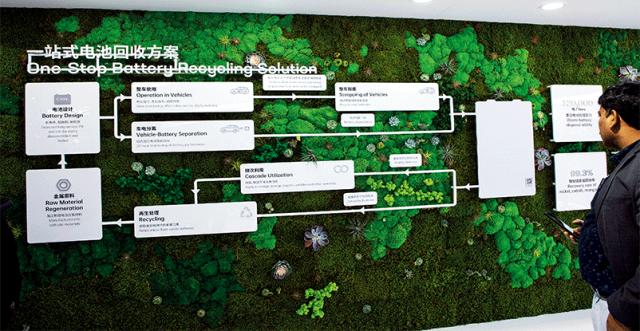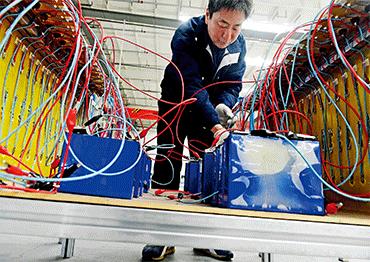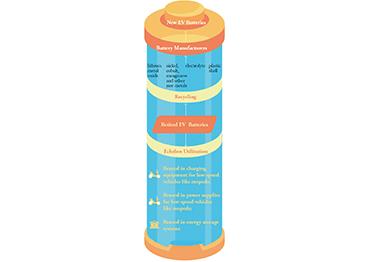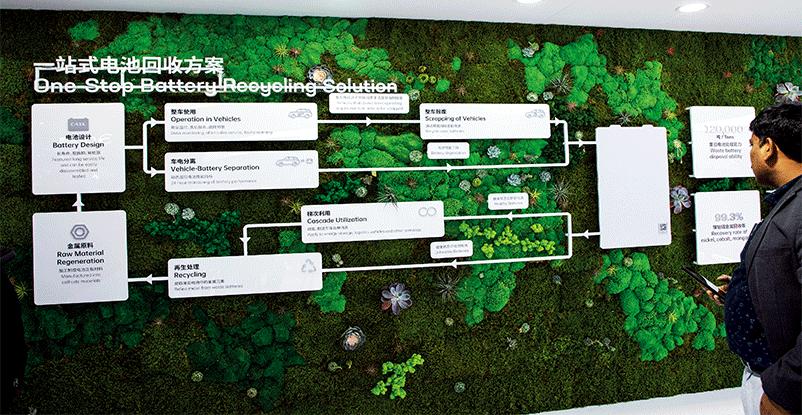As the government pushes old-for-new consumption policies, the electric vehicle battery recycling industry is scrambling to keep up with the rules, both at home and abroad

A man reads a plan for EV battery recycling displayed by CATL during the Shanghai Auto Show, April 2023 (Photo by VCG)
On March 13, the State Council issued the Action Plan to Promote Largescale Equipment Renewal and Trade-in of Old Consumer Goods, including the trade-in of old electric cars for new ones. Experts predict that 40 percent of the increase in passenger car consumption this year will come from the trade-in market.
Over the past decade, new energy vehicles (NEV) sales in China jumped from 75,000 in 2014 to 9.495 million in 2023. According to the Ministry of Public Security of China, by the end of 2023, the number of NEVs in China had reached 20.41 million, and 7.43 million vehicles were registered in 2023. The share of new energy vehicles among all new passenger vehicle sales was 31.6 percent, 5.9 percentage points higher than the same period of 2022.
Yet between the trade-in of old NEVs for new, there is a long, complex chain, and the most pressing problem is how to deal with batteries.
Industry open data indicates that by 2030, the market size of China’s power battery recycling is expected to reach 140.6 billion yuan (US$19.3b), nearly nine times more than the actual market size in 2022. This enormous market has attracted the influx of thousands of enterprises. There are only 156 companies approved to deal with waste power batteries, but according to qcc.com, an enterprise credit data platform, as of April 2024, there are at least 120,000 battery recycling enterprises.

A worker checks EV battery recycling equipment at SDM New Energy Technology, Tianjin (Photo by IC)

A worker checks EV battery materials that were recycled through phyiscal separation methods at an echelon utilization company, Weinan, Shaanxi Province (Photo by VCG)
Interest Sparked
In Late March, Zhao Xiaoyong, general manager of SDM, an EV battery recycling company based in Tianjin, told NewsChina that both new and old players in the industry are expanding. His company is set to build a new branch factory in Guangzhou, South China’s Guangdong Province.
Zhao started SDM New Energy Technology in 2016, and it made it onto the second list of firms approved to deal with waste EV batteries by the Ministry of Industry and Information Technology (MIIT). Among the 156 companies on the list, 95 are echelon utilization enterprises, 51 are recycling enterprises, and 10 are comprehensive (both echelon and recycling) enterprises. The echelon utilization of EV batteries includes the reuse of battery modules and battery cells, which can be used in various application scenarios.
The lithium battery industry has acknowledged that the power pack should be replaced when its capacity declines to 80 percent. Although the battery is no longer suitable for cars, it can be used in other areas.
“The recycling of lithium batteries is for environmental protection concerns, and it is also the last track for the new energy industry,” Zhao said. After working in the new energy industry for over two decades, Zhao said he realized the great potential for EV battery recycling. As the last mile of the green closed-loop new energy industry chain, the power battery not only has a large number of reuse demands in an echelon network, but also can bring huge benefits from the dissembling and recycling of rare and precious metal resources.
The year 2009 marked an important milestone in the development of EVs in China when the government issued the Plan for the Adjustment and Revitalization of the Automobile Industry. This provided subsidies for NEVs, and by 2013, cities like Beijing and Shanghai started promoting their use. However, these first-generation batteries only lasted three to five years, Zhao said.
“The earliest retirement of the first batch of NEVs in China laid the foundation for the large-scale development of power battery recycling after 2014,” Zhao said. Around 2016, some government policies started to mention the need for battery recycling, but it was not to the fore. For automakers, a formal recycling process meant they could get subsidies more easily, but the industry was not paying enough attention to the issue of what would happen to used batteries.
By 2018, domestic sales of electric passenger vehicles exceeded one million, and the volume of waste EV batteries skyrocketed, alongside more recycling policies and pilot projects.

A worker transfers materials at a plant owned by Hanyao, a company focusing on graphene materials, whose business includes recycling retired EV batteries, Yinchuan, Ningxia Hui Autonomous Region, August 10, 2020 (Photo by VCG)
Time to Recycle
Due to its higher profit margins, disassembly and recycling is currently the focus of the industry, as batteries account for more than 40 percent of the vehicle cost. When in 2022, the standard price for battery-grade lithium carbonate peaked at 604,000 yuan (US$83,349) per ton, thus increasing battery cost, more enterprises started to look at battery recycling.
According to data from the China Commerce Industry Research Institute, in 2018, only about 2,000 battery recycling enterprises were registered, but by 2022, there had been a 20-fold increase to 42,000 firms. In addition to third-party recycling companies and battery manufacturers, downstream car companies, upstream battery material companies and lithium mining companies have joined in.
“In order to meet the battery retirement cycle, enterprises need to prepare their factories two to three years in advance,” said Liu Gangfeng, technical director of Beijing-based battery recycler Botree Cycling. Hua’an Securities estimates that the market value of retired battery recycling will reach 169.5 billion yuan (US$23.4b) in 2030. Some brokerages and consulting agencies are more bullish, and expect the industry to exceed 100 billion yuan (US$13.8b) in as early as 2025.
Lang Xuehong, deputy secretary general of China Automobile Dealers Association, said the current general replacement cycle of traditional fuel vehicles is six to eight years, and three to five years for an NEV. It is estimated that 40 percent of the increase in passenger car market consumption this year will come from the trade-in of old cars. Based on the sales number of 26 million passenger cars in 2023, about 10 million passenger cars will come from the tradein market this year.
So far, at least 20 car brands have launched recycling programs. Cities including Chongqing and Shanghai have introduced policies addressing the tradein of old cars for new. For the purchase of NEVs, Shanghai Department of Commerce proposed a one-time subsidy of 10,000 yuan (US$1,380) until the end of 2024.
According to statistics from the China New Energy Vehicle Power Battery Recycling Industry Coordinated Development Alliance, in 2023, China generated 168,000 tons of retired power batteries, with a year-on-year growth of 78.3 percent. By the end of 2023, a total of 449,000 tons of retired power batteries had been generated, of which nearly 60 percent were generated in over the previous two years. It is estimated that by 2030, China will produce more than 1 million tons of retired power batteries every year.
“A large trade-in market for old automobiles, home appliances and other kinds of equipment will leverage the explosive growth of the power battery recycling market,” Sun Donggang, a manager with Beijing Metal Recycling Company, told NewsChina.
Despite the large profit margins generated by recycling EV batteries, it is not easy to recycle batteries of varying standards and technology. Sun warned that the current chaos in the recycling market could potentially worsen.

Battery Battle
The main recovery methods for EV batteries are hydrometallurgical recycling (wet recovery), physical material separation and pyrometallurgical (smelting) recovery. Wet treatments involve the use of chemical solutions to leach the desired minerals. Physical material separation recovers materials that are subjected to a range of physical separation processes, including sieves, filters, magnets and shaker tables. This process can separate a mixture of lithiumrich solution, low-density plastics and papers, magnetic casings, coated electrodes and electrode powders. Smelting uses a high-temperature furnace to reduce component metal oxides to an alloy. This can be further separated into component metals, and the slag typically contains the metals aluminum, manganese and lithium, which can be used in other industries like cement.
The most challenging obstacle is how to obtain the waste batteries, said Xia Yonggao, chairman of Ningbo Weifu Technology Company. “Often, officially listed recyclers lose out to small private firms who have never been approved,” Xia said.
Gao Weiqiao, deputy general manager with Zhejiang Huayou Recycle Technology Company, told the Economic Observer in January 2021 that many approved firms lose out when they bid for waste batteries to small firms, who can offer up to 15 percent more and undercut bigger companies.
Sun Donggang said these backyard firms dismantle batteries using rudimentary tools, do not issue invoices, do not adhere to environmental protection rules or buy quality equipment. “This almost zero-cost operation of course is what allows for their high bargaining power to obtain waste battery resources,” Sun said.
According to a research report released by the Development Research Center of the State Council shows that by 2023, China’s standardized recovery rate of NEV batteries is less than 25 percent. A manager from an approved company told NewsChina on condition of anonymity that more than “70 percent of waste batteries fall into the hands of second-hand vendors and backyard entities.”
Profits are hard to make when supply of batteries is insufficient. Early on, Zhao Xiaoyong started cooperating with NEV manufacturers, wreckers yards, battery producers and energy storage enterprises to source used batteries. “This year, the volume is expected to reach 10,000 tons, which is just the bottom line for our company to achieve sufficient returns,” Zhao added.
According to a manager of an approved recycling firm, the requirements to get on the official list are stringent and require a lot of up-front investment. They include site selection, equipment, environmental protection, product quality, obtaining a pollution permit and a production license. But the list is not exclusive, and non-listed firms are allowed to recycle batteries. Approved businesses, which have higher costs, are disadvantaged.
Furthermore, there is always uncertainty over the battery quality. “For us, it’s like gambling,” Xia said. Industry insiders said that lack of transparency between companies in the upstream and downstream of the lithium battery industry chain has led to difficult problems. Recycling enterprises cannot obtain useful information such as the location of the car and the location of the battery, nor a transparent transaction price.
“Most of the scrapped batteries end up falling into small private companies and the echelon utilization market without proper regulation and supervision. Regular officially approved recycling enterprises have difficulty getting scrap battery resources, leaving significant high-quality recycling capacity idle,” Zeng Yuqun, chairman of EV battery maker Contemporary Amperex Technology Company, said publicly during the two sessions in 2023.
Producer Responsibility
Zhao Xiaoyong said that among the five major recycling channels he established, he gets most batteries from scrapped vehicles.
As the upstream of battery recycling enterprises, wreckers’ yards provide about 60 percent of used batteries. Sun Donggang said that used EVs are either sold or go to scrap yards.
Scrapping and dismantling enterprises are under the joint management of both the Ministry of Commerce and the Ministry of Public Security, Sun said. But the current scrapping standards for NEVs have not been implemented yet, which means no mandatory regulations are in place to require that scrapped NEVs must have batteries.
“Take our company as an example, we can only get about 10 batteries from every 1,000 scrapped new energy vehicles,” Sun said. The vehicle owner also owns the battery, so they often sell it separately to make more money.
“The loss of used batteries more often occurs in the circulation step, and automobile manufacturers are the key entry point for solving this problem,” a senior industry insider in auto recycling told NewsChina under condition of anonymity.
In December 2023, the MIIT drafted a document titled The Comprehensive Utilization of New Energy Vehicle Power Batteries Management Measures, which will require vehicle manufacturers to take responsibility for recycling installed vehicle batteries, and battery producers to be responsible for those they sell directly.
The producer responsibility principle was clarified for the first time in the NEV industry. In the sales stage, this draft document requires automakers to record the traceability information of the vehicle and its owner, clarify the requirements and procedures for the maintenance, retirement and recycling of batteries, and inform vehicle owners when batteries should be retired. Car companies must set up collection and recycling points.
These measures encourage all enterprises to jointly build and share recycling channels. Some industry leaders are cooperating. In 2013, CATL purchased Guangdong Brunp Recycling Technology, and in 2018, CATL reached a strategic cooperation with SAIC Motor.
“To promote the implementation of the extended producer responsibility system is actually to let the car enterprises transition from the original production management to utilization management,” the senior industry insider for auto recycling said. This battery recycling is also a sign of big companies paying their dues to society, as it is not as profitable as their main manufacturing business and it requires additional labor and technical costs.
Overseas Rules
The overseas market for power battery recycling is also booming and yet has become more challenging. Liu Gangfeng said that since 2022, more companies started to consult about the overseas market for battery recycling.
According to data released by the China Association of Automobile Manufacturers in January, China’s automobile exports reached 4.91 million vehicles in 2023, making it the world’s largest automobile exporter. Non-trade barriers to exports have continued to increase. The newly implemented EU regulation on batteries and waste batteries in August 2023 will require that after 2027, exports of power batteries to Europe must have a required “battery passport” to record the battery manufacturer, material composition, carbon footprint, supply chain and other information.
“The first challenge for Chinese battery producers who export to Europe is the regulation issue,” Liu said. Starting from July 1, only batteries with a declared carbon footprint will be allowed into the European market, which means that battery exporters need to collect, calculate and disclose carbon emission data from upstream minerals and materials to battery production, recycling and reuse.
However, Chinese battery companies are lagging when it comes to setting up databases for their full life-cycle carbon footprint.
The establishment of a “battery passport” involves disclosure from many enterprises in the upstream and downstream of the whole industrial chain, which not only poses technical difficulties but also may cause potential risks.
To meet the overseas market requirements, many Chinese battery companies have been deploying zero-carbon transformation strategies and exploring solutions such as battery carbon footprints, digital battery passports, recycling materials and traceability.
According to the new rules of producer responsibility, starting from February 2025, EV batteries exported to Europe will be calculated in accordance with the European battery carbon footprint rules and approved by EU-recognized certification organization, otherwise they cannot be sold on the European market.
“It will definitely increase costs when we ask suppliers to provide data and information, and as the threshold for enterprises to export overseas is raised, the battery recycling industry may have to prepare two modes to address the domestic and overseas market separately,” Liu said.

 Old Version
Old Version




